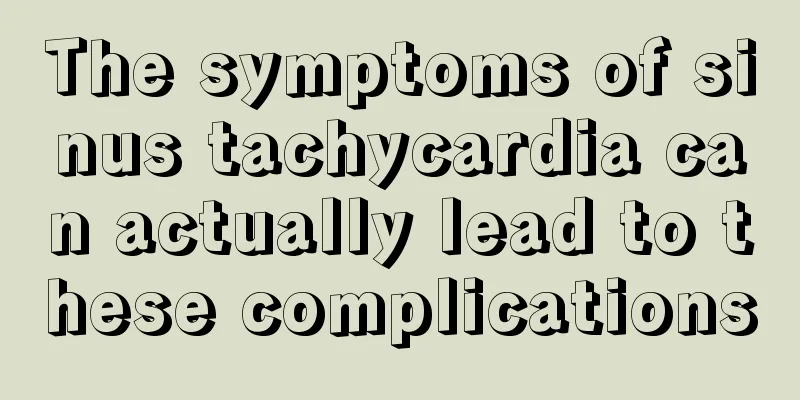The symptoms of sinus tachycardia can actually lead to these complications

|
Sinus tachycardia is a common disease. Once an attack occurs, patients will experience symptoms such as palpitations, shortness of breath, dizziness, fatigue, and sweating. If not treated in time, it may also cause arrhythmias and angina pectoris. Therefore, active and correct treatment is necessary to be on the safe side. 1. Clinical manifestations 1. Palpitations, or sweating, dizziness, blurred vision, fatigue, or symptoms of underlying disease. 2. It may induce other arrhythmias or angina pectoris. 3. The heart rate is mostly between 100 and 150 beats per minute, and most heart sounds are strong or there are signs of primary heart disease. 2. Complications The disease is often caused by other diseases, so its complications are related to the cause. Common complications include corresponding critical symptoms such as acute pulmonary edema, heart failure, and cardiogenic shock. 1. Pulmonary edema Pulmonary edema is an increase in lung water content caused by a disorder in the fluid exchange function between blood vessels and tissues in the lungs. This disease can seriously affect respiratory function and is a common cause of acute respiratory failure in clinical practice. The main clinical manifestations are extreme dyspnea, orthopnea, cyanosis, profuse sweating, paroxysmal coughing accompanied by large amounts of white or pink frothy sputum, symmetrical moist rales in both lungs, and butterfly-shaped, flake-like fuzzy shadows in both lungs on chest X-rays. Shock and even death may occur in the late stages. Arterial blood gas analysis may show low O2, low CO2 partial pressure, severe O2 deficiency, CO2 retention and mixed acidosis in the early stages. 2. Heart failure Heart failure is divided into left heart failure and right heart failure. The main symptoms of left heart failure are fatigue, dyspnea, which initially occurs during exertion and eventually develops into dyspnea at rest, and the patient can only breathe while sitting up. Paroxysmal dyspnea is a typical manifestation of left heart failure, which often occurs during deep sleep and is characterized by chest tightness, shortness of breath, cough, and wheezing. In particularly severe cases, it can develop into acute pulmonary edema with symptoms of severe wheezing, orthopnea, extreme anxiety, and coughing up foamy mucus (typically pink foamy sputum), cyanosis, and other symptoms of lung congestion. The main manifestations of right heart failure are lower limb edema, distended neck veins, loss of appetite, nausea and vomiting, oliguria, nocturia, and separation of drinking and urination. 3. Cardiogenic shock Cardiogenic shock refers to a syndrome in which the cardiac function is extremely impaired, resulting in a significant decrease in cardiac output and causing severe acute peripheral circulatory failure. The main clinical manifestations are severe underlying heart disease symptoms. Symptoms of systemic circulatory failure include persistent hypotension, oliguria, impaired consciousness, peripheral cyanosis, etc. It may also be accompanied by acute pulmonary edema and changes in hemodynamic indicators, that is, arterial pressure <10.7KPa (80mmHg), central venous pressure may be normal or high, but cardiac output is extremely low. |
<<: What should I do if my lumbar spine is not in good condition
>>: Is lumbar radiofrequency surgery good?
Recommend
Tips for repelling insects in the room
There are many reasons why insects enter the room...
What are some exercises for back training?
The back muscle group is one of the larger muscle...
Experts teach you how to prevent osteosarcoma in daily life
Everyone is afraid when they hear the word "...
How to get rid of body odor
Many people don’t know how to get rid of body odo...
22 points on the correct diet and weight loss method. Please read on patiently
Dieting is a popular weight loss method nowadays....
For patients with gallbladder cancer, it is important to do a good job of nursing them
In recent years, the incidence of gallbladder can...
What disease causes morning stiffness
Morning stiffness is a common clinical symptom, m...
What can people eat to grow taller
We eat a lot of things every day, but some foods ...
How to recover from wrist pain when supporting yourself with your hands
When we are doing military training, many instruc...
Can I eat Cordyceps if I have advanced lung cancer?
If there are obvious clinical manifestations and ...
What are the methods to whiten and remove yellow teeth?
Many people hope to have a set of white teeth so ...
Seven alternative anti-cancer methods
Why do humans get cancer? Numerous medical studie...
What are the early symptoms of liver cancer? The 4 most obvious symptoms of early liver cancer
Experts point out that if you find yourself exper...
Can I eat sweet potatoes if I have constipation?
I believe that many people often experience sympt...
What are the treatments for lumbar disc bulging
Lumbar disc bulging is a major cause of low back ...









